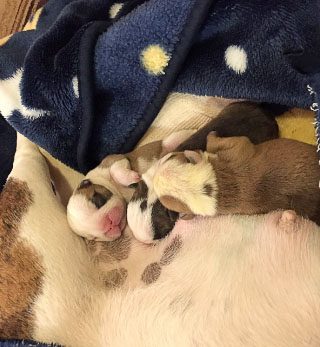Prenatal Care
Preparing for your dog’s labor and puppy care can be both exciting and fun; still, awareness of potential problems is of paramount importance. It is a good idea to keep track of your dog’s breeding date so as to know when to expect what.
After about 35 days of pregnancy, the mother’s caloric requirements will begin to increase. When she begins nursing she will need two to three times as much food. The best nutritional plan is to buy a dog food approved for growth (i.e., puppy food) and feed according to the package; such diets are balanced and require no supplementation, plus they typically have the extra calories needed by the pregnant or nursing mother. Exercise of a pregnant bitch need not be restricted until after the first 4 to 6 weeks of pregnancy. Do not supplement calcium as this can cause metabolic imbalances; also, excess vitamins may be harmful to the puppies.
Sometime around the 50th day, your dog should be examined by a vet. At this time, the skeletons of the unborn pups will have mineralized and are thus visible on a radiograph. Your dog’s abdomen should be x-rayed so that you know how many pups to expect. Ultrasound may be used to confirm pregnancy much earlier (after 25 days, the embryonic heart may be seen beating) but it can be more difficult to count the number of pups using this method.
A comfortable area should be set aside for whelping and raising the puppies. The bitch should feel at home here and should be able to come and go as she likes while the puppies must remain confined.
It is important that the mother dog be isolated from all other dogs for 3 weeks prior to labor through 3 weeks after delivery to prevent herpes infection. Herpes is spread by sniffing and licking between two dogs. Adult dogs rarely have any symptoms but the newborn or unborn puppies generally die.
A dog’s gestation period is considered to be 63 days from ovulation, but time from breeding can vary from 55 to 65 days.
Impending Labor
When your dog’s due date is approaching, you should begin monitoring her rectal temperature. When her temperature drops below 99°F (normal canine temperature is 101-102°F), labor may be expected within 24 hours. This is not 100% accurate. Watching for change in eating habits can also be helpful, as most dogs will not eat in labor is pending.
The First Stage of Labor: During this stage, uterine contractions begin. The bitch will appear restless and may pace, dig, shiver, pant, or even vomit. This is all normal and all an owner can do is see that she has water available should she want it. This stage of labor is long, lasting 6 to 12 hours and culminates with full dilation of the cervix in preparation to expel a puppy.
The Second and Third Stages of Labor: The second stage is the hard labor stage in which the puppy is expelled. The third stage refers to the expulsion of the placenta and afterbirth. Each pup may not be followed by afterbirth; the mother may pass two pups and then two placentas. This is normal.
Puppies are born covered in membranes that must be cleaned away or the pup will suffocate. The mother will bite and lick the membranes away. Allow her a minute or two after birth to do this; if she does not do it, then you must clean the pup for her. Simply remove the slippery covering and rub the puppy with a clean towel. The umbilical cord may be tied in a knot about one inch from the pup and cut with scissors on the far side of the knot. Be careful not to pull on the umbilical cord as this can injure the puppy. The mother may want to eat the placenta but this is probably not a good idea as vomiting it up later is common; it is best to clean away the placenta yourself.
Expect one pup every 45 to 60 minutes with 10 to 30 minutes of hard straining. It is normal for bitches to take a rest partway through delivery, and she may not strain at all for up to 2 hours between pups. If she is seen straining hard for over one hour or if she takes longer than a 2 hour break, a veterinarian should be consulted.
Expect some puppies (probably half of them) to be born tail first. This is not abnormal for dogs.
CALL US IF:
- 30-60 minutes of strong contractions occur with no puppy being produced.
- More than 2 hours pass between pups and you know there are more inside.
- She fails to go into labor within 24 hours of her temperature drop.
- She is obviously in extreme pain.
- Greater than 70 days of gestation have passed.
Normal vaginal discharge after parturition should be odorless and may be green, dark red-brown or bloody and may persist in small amounts for up to 8 weeks.
Breeding and Whelping FAQs



